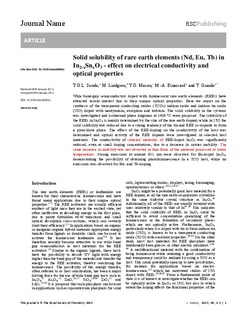| dc.contributor.author | Sunde, Tor Olav Løveng | |
| dc.contributor.author | Lindgren, Mikael | |
| dc.contributor.author | Mason, TO | |
| dc.contributor.author | Einarsrud, Mari-Ann | |
| dc.contributor.author | Grande, Tor | |
| dc.date.accessioned | 2014-11-24T13:47:28Z | |
| dc.date.accessioned | 2015-06-08T11:27:29Z | |
| dc.date.available | 2014-11-24T13:47:28Z | |
| dc.date.available | 2015-06-08T11:27:29Z | |
| dc.date.issued | 2014-05-07 | |
| dc.identifier.citation | Dalton Transactions 2014, 43(25):9620-9632 | nb_NO |
| dc.identifier.issn | 1477-9226 | |
| dc.identifier.uri | http://hdl.handle.net/11250/284781 | |
| dc.description.abstract | Wide band-gap semiconductors doped with luminescent rare earth elements (REEs) have
attracted recent interest due to their unique optical properties. Here we report on the
synthesis of the transparent conducting oxides (TCOs) indium oxide and indium tin oxide
(ITO) doped with neodymium, europium and terbium. The solid solubility in the systems
was investigated and isothermal phase diagrams at 1400 °C were proposed. The solubility of
the REEs in In2O3 is mainly determined by the size of the rare earth dopant, while in ITO the
solid solubility was reduced due to a strong tendency of the tin and REE co-dopants to form
a pyrochlore phase. The effect of the REE-doping on the conductivity of the host was
determined and optical activity of the REE dopants were investigated in selected host
materials. The conductivity of sintered materials of REE-doped In2O3 was significantly
reduced, even at small doping concentrations, due to a decrease in carrier mobility. The
same decrease in mobility was not observed in thin films of the material processed at lower
temperatures. Strong emissions at around 611 nm were observed for Eu-doped In2O3,
demonstrating the possibility of obtaining photoluminescence in a TCO host, while no
emissions was observed for Nd- and Tb-doping. | nb_NO |
| dc.language.iso | eng | nb_NO |
| dc.publisher | Royal Society of Chemistry | nb_NO |
| dc.title | Solid solubility of rare earth elements (Nd, Eu, Tb) in In2−xSnxO3 – effect on electrical conductivity and optical properties | nb_NO |
| dc.type | Journal article | nb_NO |
| dc.type | Peer reviewed | en_GB |
| dc.date.updated | 2014-11-24T13:47:28Z | |
| dc.source.pagenumber | 9620-9632 | nb_NO |
| dc.source.volume | 43 | nb_NO |
| dc.source.journal | Dalton Transactions | nb_NO |
| dc.source.issue | 25 | nb_NO |
| dc.identifier.doi | 10.1039/c4dt00850b | |
| dc.identifier.cristin | 1168054 | |
| dc.description.localcode | This is the authors accepted refereed manuscript to the article. © The Royal Society of Chemistry 2013. | nb_NO |

